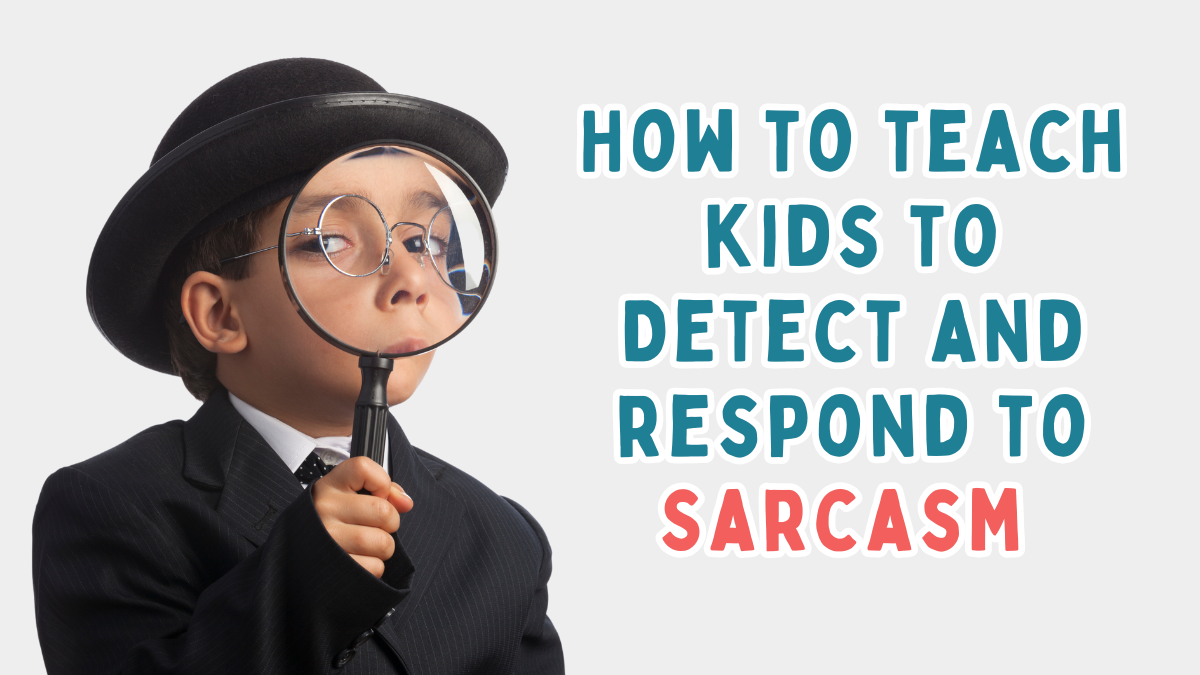How To Teach Sarcasm to Kids

Help students recognize and respond to sarcasm with clear strategies, role-playing, and practice. Build social confidence with engaging activities!
How to Teach Kids To Understand and Respond to Sarcasm
Understanding sarcasm is a significant social skill that many children struggle to master. While neurotypical children often pick up sarcasm seemingly naturally through social interactions and the general feelings they get through these interactions, many students, especially those with social communication challenges, need explicit instruction to recognize, understand, and respond to sarcastic comments.
Why Teaching Sarcasm Matters
Sarcasm is part of advanced social communication that appears more frequently in daily interactions as children enter upper elementary and middle school years. If it’s not understood accurately, things can get messy.
Consider these scenarios:
A student misinterprets a friend's sarcastic "Nice job!" after missing the basketball shot as genuine praise.
A child takes offense when a peer playfully says "Thanks a lot!" after they accidentally bump into them.
A child becomes confused when their brother sees moldy cheese on the kitchen counter and says, "Oh look, your favorite!”
Without the ability to detect sarcasm, children may:
Misunderstand social situations
Miss out on playful interactions and shared humor
Experience difficulty forming and maintaining friendships
Feel left out of peer group interactions
Struggle with conversations
Common Struggles with Detecting Sarcasm
Children often face several challenges when learning to understand sarcasm for various reasons:
Literal Interpretation
Many students, especially those with autism or language processing difficulties, tend to interpret words at face value. They are thinking concretely and not picking up on underlying tones, facial expressions, or contextual clues that indicate sarcasm.
For example, imagine a teacher is giving directions, and a student accidentally drops a stack of papers, causing a distraction. If the teacher says, “Just what I needed!”, a student who takes language literally may not recognize that this phrase actually means the opposite of the spoken words. This gap in understanding can lead to confusion, frustration, and even social isolation.
Missing Nonverbal Cues
Sarcasm often relies on tone of voice, facial expressions, and body language. If a speaker rolls their eyes or uses an exaggerated voice, a neurotypical listener can typically recognize the sarcasm. However, students who struggle with social communication may not naturally tune into these cues.
Context Confusion
Understanding sarcasm requires processing both the literal meaning of words and the context in which they're used. This dual processing can be overwhelming for many students. Understanding sarcasm requires students to evaluate what just happened, who is speaking, and whether the phrase aligns with reality.
Processing Speed
Some students need more time to process language, especially when it involves abstract or implied meanings. Sarcasm requires quick thinking. By the time a student figures out that a certain comment was sarcastic, the conversation may have already moved on.
Key Strategies for Teaching Sarcasm
1. Start with observations
Begin by teaching students that sarcasm occurs when:
Words mean the opposite of their literal meaning
Context doesn't match the literal words
Tone of voice provides clues
Facial expressions and body language signal sarcasm
2. Teach Sarcasm Detection Cues
Help students identify key indicators of sarcasm by these 5 observations:
Tone of Voice:
Elongated words
Emphasis on certain syllables
Exaggerated pronunciation
Changed pitch
Facial Expressions:
Eye rolling
Raised eyebrows
Smirking
Exaggerated expressions
3. Context: Understanding When Words Don’t Match Reality
One of the biggest clues that sarcasm is being used is when the comment doesn’t match what actually happened. This disconnect between words and reality is a key feature of sarcasm, but students who take language literally may struggle to notice it.The Speaker’s Emotion Doesn’t Match the Words
The Situation is the Opposite of What’s Being Said
Prior Knowledge of the Speaker’s Intentions
How to Respond to Sarcasm
Recognizing sarcasm is only half the battle. Teaching students how to respond appropriately is just as important. Some students may feel confused, while others might react emotionally if they misunderstand the intent behind a sarcastic remark. Guiding them through response strategies can help them navigate social situations more smoothly.
Choose an Appropriate Response
Laugh if it's meant to be funny
Reply with similar humor if appropriate
Ignore it if it's meant to be hurtful
Ask for clarification if unsure
Practice Response Strategies
Role-play different scenarios
Discuss appropriate versus inappropriate responses
Build confidence through guided practice
Teaching sarcasm is best done by breaking it down into manageable components and providing plenty of structured practice opportunities. By gradually building their understanding of tone, context, and nonverbal cues, we can help students develop the skills needed to interpret and respond to sarcasm accurately.

Understanding and Responding to Sarcasm activity resource provides visual guides to help kids understand what to look out for when detecting sarcasm as well as role-playing exercises to help students grasp sarcasm in an engaging way. It’s designed to help students recognize sarcasm, interpret intent, and choose appropriate responses in various relevant social situations.
Students benefit most when we combining direct instruction with physical practice. This helps students feel more confident when encountering sarcasm in their daily interactions. You can see a educator's guide to teaching sarcasm in the video below.

It's important to create a supportive learning environment where students feel comfortable making mistakes and learning from them. Some students may take longer than others to grasp sarcasm, but with ongoing exposure and reinforcement, they can gain confidence in recognizing and even using it appropriately
While sarcasm can be tricky to master, it plays a significant role in humor, friendships, and social interactions. Helping students understand it not only improves their communication skills but also strengthens their ability to connect with others in a meaningful way.
Categories: : sarcasm

I'm a Board Certified Behavior Analyst and former Special Education Teacher dedicated to teaching kids the 21st Century Social Skills they need to live happier, healthier lives
Diana Cortese
Founder, Teach Social Skills
 Diana Cortese
Diana Cortese 
